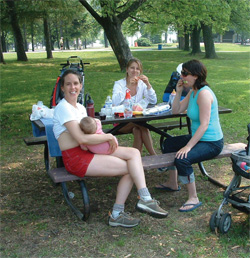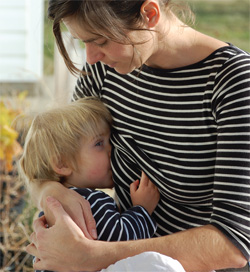Breastfeeding phases

![]() Breastfeeding with your baby snuggled in your arms comforts him and helps meet many of his important needs.
Breastfeeding with your baby snuggled in your arms comforts him and helps meet many of his important needs.
A nursing woman’s breasts undergo changes as her milk supply fluctuates in response to her baby’s needs. As children get older, their behaviour changes too—they’ll state their needs more and more clearly. Everything seems to get easier with time.
The table below provides an overview of breastfeeding phases between birth and the age of 6 months, describing your baby’s behaviour and what may happen at feedings.
Right after birth: Mother and child get acquainted
Your baby
- Will instinctually seek your breast within an hour of birth.
- Will then sleep for several hours.
- May find it harder to breastfeed if she has taken more time to recover from delivery.
Feedings
- Offer baby your breast if she seems interested.
- If she doesn’t nurse right away, hold her close until she shows interest.
- The interval between the first two feedings can vary.
- If necessary:
- Let a few drops of milk drip onto her mouth, but don’t insist if she refuses—be patient;
- Express milk and give it to her from a spoon or small cup. Avoid bottles for the time being.
The first 14 days: A time of learning for mother and child
Your baby
- May be drowsy, especially if she is jaundiced.
- May sleep so much that you need to waken her up to ensure she gets enough nourishment, i.e., 8 times or more per day (24 hours).
- Tends to fall asleep at your breast as soon as the flow of milk slows, even if she hasn’t drunk enough.
Feedings
- It can take a long time to get ready and latching on may be difficult. A feeding session (breastfeeding, stimulation, burping and diaper-changing) may take between 45 and 90 minutes.
- The number and length of feedings is less important than the quality of the latch and effectiveness of the sucking. Babies who suck effectively spend less time at the breast and are less likely to hurt your nipples.
- If your baby falls asleep while you breastfeed, try tickling her, uncovering her, holding her close or talking to her. Make sure she latches on properly. Try using the breast compression technique.
2 to 8 weeks: Mother and child are more comfortable with each other
Your baby
- Awakens on her own for feeding and stays awake for longer periods.
Feedings
- You’re getting better at latching on and feeling more at ease as you get to know your little one better.
- Between weeks 6 and 8, your breasts produce as much milk as before but become softer to the touch and smaller in size as they adjust to your baby’s needs.
From 2 to 6 months: Mother and child have their own routine
Your baby
- Expresses her needs more readily—for example, when she wants to change breasts.
- Needs more stimulation; it’s not always easy to know if she’s hungry or wants to do something different.
Feedings
- Feedings are shorter.
- At 3 months, baby tends to look around her while nursing.
- At 4 months, baby’s appetite changes: she may ask for the breast more often. She may still wake up at night for feeding—or start doing so again.
Breastfeeding an older baby (6 months and up)
Breastfeeding an older baby and a newborn are two very different things. Once children start eating other foods at around 6 months of age, the rhythm of breastfeeding gradually changes as your baby adapts to the family’s mealtime routine. But you and your child can still benefit from the advantages of breastfeeding, which will continue as long as you carry on nursing.
As your child gets older, he will start to show curiosity and initiative, and this can carry over into breastfeeding. His newfound independence may sometimes pose problems—he might ask for your breast at inconvenient times. But trust yourself: in breastfeeding, as in parenting in general, you’ll learn to set limits on what you consider to be acceptable or not. Your baby will learn to be a bit more patient and will get used to breastfeeding on your terms.
As children near one year of age, they typically breastfeed only a few times per day, although some may still do so more frequently. At this age, the number of feedings varies from one day to the next, depending on the child’s activities and mood.
In Québec, an increasing number of women are continuing to breastfeed beyond age 1—even if only once a day— because it helps prolong the special mother–child relationship they cherish. Breastfeeding for a longer period has ongoing health benefits for the baby. Many find that breastfeeding in the evening is an enjoyable part of the bed-time ritual. Support group volunteers are very comfortable with the idea of breastfeeding a toddler. Feel free to discuss it with them.
Breastfeeding in public

![]() Breastfeeding makes it easier for a family to get out and about! Night or day, milk is always handy—whether you’re at the movies, outdoors, visiting or traveling.
Breastfeeding makes it easier for a family to get out and about! Night or day, milk is always handy—whether you’re at the movies, outdoors, visiting or traveling.
More and more women are breastfeeding in public. It’s your right to breastfeed your child, regardless of the location. In Québec, that right is protected by law. Breastfeed with self-confidence and simplicity. To make things easier, try wearing layered garments (for example, a T-shirt and sweater) or a blouse. Some places provide special breastfeeding and baby care areas for parents who don’t feel comfortable nursing in public.
Breastfeeding and mother–child separation
One practical side of breastfeeding is that it makes family outings easier. However, your personal or professional activities may also require you to be separated from your child.
You can continue breastfeeding even if you’re not always with your child. You’ll need to consider
- The child’s age
- His preferences, and yours
- The length and frequency of separation
Once babies reach 6 months of age, they don’t necessarily need to be bottle-fed when you’re away; they can learn to satisfy their thirst by drinking from a cup.
Occasional separations
Need to go out for a few hours? If you breastfeed your baby before you leave and once you return, it may not be necessary for anyone to bottle-feed him while you’re out.
If you know that you’re going out for a while, you can express milk that your baby can drink from a cup or bottle, depending on his age and abilities. He may only drink a small amount—that happens sometimes. But don’t worry—he’ll probably have a “full-course meal” once you return.
And while you’re out, you may need to express milk in order to relieve breast discomfort. Take along what you need (for instance, a cooler and ice packs) to keep the milk cool until you return home.

![]() This special relationship can be continued as long as you and your child wish.
This special relationship can be continued as long as you and your child wish.
Returning to work or school
Returning to work or school will require you to be away from your baby on a regular basis for longer periods. Yet many women in this situation continue breastfeeding. A number of them talk about the pleasure they get from snuggling up with their nursing babies before they go out or after they return.
Once expressed, breast milk can be refrigerated or frozen, then given to your child in a cup or bottle in keeping with his age and abilities. This way you continue to provide excellent nourishment that will help your infant develop and stay healthy—whether you’re by his side or not.
At age 6 months or so, it’s not unusual for some babies who are separated from their moms to prefer food until they can breastfeed. They may drink very little while their mothers are away, but make up for this by nursing more heavily the rest of the time.
You may also decide to breastfeed when you’re with your child and to provide another type of age-appropriate milk for him when you’re not around. Your milk production will adjust if you opt for what is called “mixed feeding”.
Express: Pump or squeeze milk from the mother’s breast.


